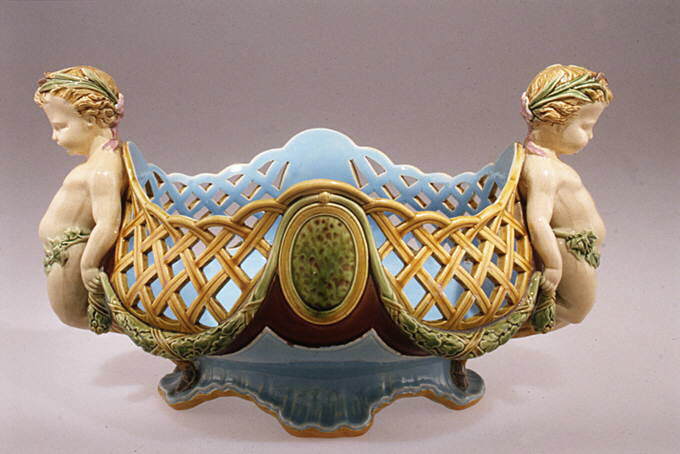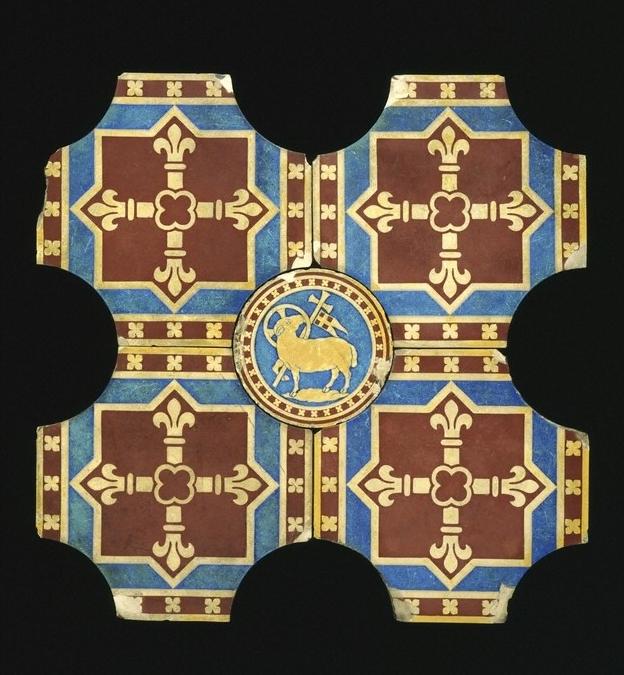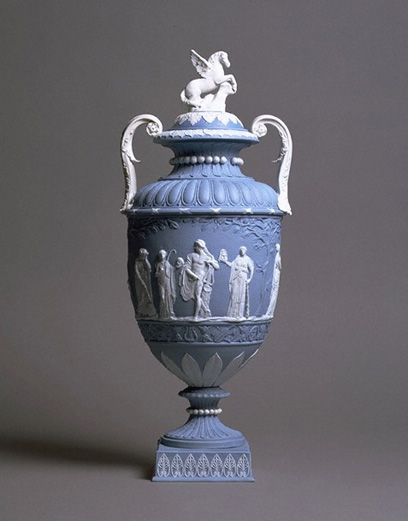|
Pâte-sur-pâte
''Pâte-sur-pâte'' is a French term meaning "paste on paste". It is a method of porcelain decoration in which a relief design is created on an unfired, unglazed body, usually with a coloured body, by applying successive layers of (usually) white porcelain slip (ceramics), slip (liquid clay) with a brush. Once the main shape is built up, it is carved away to give fine detail, before the piece is fired. The work is very painstaking and may take weeks of adding extra layers and allowing them to harden before the next is applied. The usual colour scheme is a white relief on a contrasting coloured background, which in England was often Parian ware. The effect is somewhat similar to other types of relief decoration, in particular Sprigging (decorative), sprigging. However, unlike Jasperware, for example, a mould is not normally used, and the ceramic artist is able to achieve translucency. The method also gives results resembling Cameo (carving), cameos in stone or cameo glass. The ... [...More Info...] [...Related Items...] OR: [Wikipedia] [Google] [Baidu] |
Marc-Louis Solon
Marc-Louis-Emmanuel Solon (1835 – 23 June 1913), pseudonym ''Miles'', was a French porcelain artist. After beginning his career at the Manufacture nationale de Sèvres, Sèvres Pottery, he moved to Stoke-on-Trent in 1870 to work at Mintons Ltd, where he became the leading exponent of the technique of ceramic decoration called ''pâte-sur-pâte''. His work commanded high prices in the late Victorian period. Solon was born in Montauban, Tarn-et-Garonne. After moving to England at the time of the Franco-Prussian War he lived there for the rest of his life. Family Solon married Laure, the daughter of Minton's art director, Léon Arnoux, and the Solons raised a large family in The Villas near the Mintons factory. Their eldest son, Léon-Victor Solon (1872–1957), joined Minton in the 1890s and became art director (1900–1909). Leon made an important contribution to Art Nouveau ceramics at Minton before moving to the United States. Other notable sons include Camille Solon and ... [...More Info...] [...Related Items...] OR: [Wikipedia] [Google] [Baidu] |
Mintons Ltd
Mintons was a major company in Staffordshire pottery, "Europe's leading ceramic factory during the Victorian era", an independent business from 1793 to 1968. It was a leader in ceramic design, working in a number of different ceramic bodies, decorative techniques, and "a glorious pot-pourri of styles - Rococo shapes with Oriental motifs, Classical shapes with Medieval designs and Art Nouveau borders were among the many wonderful concoctions". As well as pottery vessels and sculptures, the firm was a leading manufacturer of tiles and other architectural ceramics, producing work for both the Houses of Parliament and United States Capitol. The family continued to control the business until the mid-20th century. Mintons had the usual Staffordshire variety of company and trading names over the years, and the products of all periods are generally referred to as either "Minton", as in "Minton china", or "Mintons", the mark used on many. Mintons Ltd was the company name from 1879 o ... [...More Info...] [...Related Items...] OR: [Wikipedia] [Google] [Baidu] |
Mintons
Mintons was a major company in Staffordshire pottery, "Europe's leading ceramic factory during the Victorian era", an independent business from 1793 to 1968. It was a leader in ceramic design, working in a number of different ceramic bodies, decorative techniques, and "a glorious pot-pourri of styles - Rococo shapes with Oriental motifs, Classical shapes with Medieval designs and Art Nouveau borders were among the many wonderful concoctions". As well as pottery vessels and sculptures, the firm was a leading manufacturer of tiles and other architectural ceramics, producing work for both the Palace of Westminster, Houses of Parliament and United States Capitol. The family continued to control the business until the mid-20th century. Mintons had the usual Staffordshire variety of company and trading names over the years, and the products of all periods are generally referred to as either "Minton", as in "Minton china", or "Mintons", the mark used on many. Mintons Ltd was the co ... [...More Info...] [...Related Items...] OR: [Wikipedia] [Google] [Baidu] |
Frederick Alfred Rhead
Frederick Alfred Rhead (1856–1933) was a potter working in North Staffordshire, England. He is not to be confused with his son Frederick Hurten Rhead (1880–1942) who was also a potter, and who worked mainly in the USA. His other children included the pottery designer Charlotte Rhead. Rhead's father, G.W. Rhead, worked in the pottery industry, and young Frederick was apprenticed at Mintons Ltd. He was one of a number of apprentices who in the 1870s learnt the art of ''pâte-sur-pâte'' decoration from Marc-Louis Solon, a French émigré who was the leading exponent of this ceramic technique. Rhead continued to work in ''pâte-sur-pâte'' after leaving Minton. He joined Wedgwood and went on to work at a number of potteries including a failed venture of his own. His most famous piece of ceramics is the "Gladstone Vase" which was presented to William Ewart Gladstone by the Liberals of Burslem in 1888. The vase is on public view, having been loaned to the Gladstone Pottery Muse ... [...More Info...] [...Related Items...] OR: [Wikipedia] [Google] [Baidu] |
Imperial Porcelain Factory, Saint Petersburg
The Imperial Porcelain Factory (), also known as the Imperial Porcelain Manufactory (abbreviated as IPM), is a producer of hand-painted ceramics in Saint Petersburg, Russia. It was established by Dmitry Ivanovich Vinogradov in 1744 and was supported by the Russian tsars since Empress Elizabeth. Many still refer to the factory by its well-known former name, the Lomonosov Porcelain Factory. History 18th century Attempts to develop the secret of hard-paste porcelain had been in progress in Russia since the visit of Peter the Great to Saxony in 1718; there, he saw Meissen porcelain at the Dresden court. Dmitry Ivanovich Vinogradov, a talented mining engineer who studied metallurgy at Freiberg, Saxony, developed the formula for the first porcelain manufactory in Russia, established in 1744 by order of Empress Elizabeth, daughter of Peter the Great, to "serve native trade and native art."The Lomonosov Porcelain Story, , accessed 18 June 2007 For a long time, the factory produced ... [...More Info...] [...Related Items...] OR: [Wikipedia] [Google] [Baidu] |
Jasperware
Jasperware, or jasper ware, is a type of pottery first developed by Josiah Wedgwood in the 1770s. Usually described as stoneware, it has an unglazed matte "biscuit" finish and is produced in a number of different colours, of which the most common and best known is a pale blue that has become known as " Wedgwood blue". Relief decorations in contrasting colours (typically in white but also in other colours) are characteristic of jasperware, giving a cameo effect. The reliefs are produced in moulds and applied to the ware as sprigs. After several years of experiments, Wedgwood began to sell jasperware in the late 1770s, at first as small objects, but from the 1780s adding large vases. It was extremely popular, and after a few years many other potters devised their own versions. Wedgwood continues to make it into the 21st century. The decoration was initially in the fashionable Neoclassical style, which was often used in the following centuries, but it could be made to suit oth ... [...More Info...] [...Related Items...] OR: [Wikipedia] [Google] [Baidu] |
Albert-Ernest Carrier-Belleuse
Albert-Ernest Carrier-Belleuse (; born Albert-Ernest Carrier de Belleuse; 12 June 1824 – 4 June 1887) was a French sculptor. He was one of the founding members of the Société Nationale des Beaux-Arts, and was made an officer of the Legion of Honour. Early life Carrier-Belleuse was born on 12 June 1824 at Anizy-le-Château, Aisne, France. He began his training as a goldsmith's apprentice. Carrier-Belleuse was a student of David d'Angers and briefly studied at the École des Beaux-Arts. His career is distinguished by his versatility and his work outside France: in England between 1850 and 1855 (working for Mintons), and in Brussels around 1871. His name is perhaps best known because Auguste Rodin worked as his assistant between 1864 and 1870. The two travelled to Brussels in 1871, and by some accounts Rodin assisted Carrier-Belleuse's architectural sculpture for the Brussels Stock Exchange. Career Carrier-Belleuse made many terra cotta pieces, the most famous of which m ... [...More Info...] [...Related Items...] OR: [Wikipedia] [Google] [Baidu] |
Franco-Prussian War
The Franco-Prussian War or Franco-German War, often referred to in France as the War of 1870, was a conflict between the Second French Empire and the North German Confederation led by the Kingdom of Prussia. Lasting from 19 July 1870 to 28 January 1871, the conflict was caused primarily by France's determination to reassert its dominant position in continental Europe, which appeared in question following the decisive Austro-Prussian War, Prussian victory over Austria in 1866. According to some historians, Prussian chancellor Otto von Bismarck deliberately provoked the French into declaring war on Prussia in order to induce four independent southern German states—Grand Duchy of Baden, Baden, Kingdom of Württemberg, Württemberg, Kingdom of Bavaria, Bavaria and Grand Duchy of Hesse, Hesse-Darmstadt—to join the North German Confederation. Other historians contend that Bismarck exploited the circumstances as they unfolded. All agree that Bismarck recognized the potential for new ... [...More Info...] [...Related Items...] OR: [Wikipedia] [Google] [Baidu] |
Staffordshire
Staffordshire (; postal abbreviation ''Staffs''.) is a Ceremonial counties of England, ceremonial county in the West Midlands (region), West Midlands of England. It borders Cheshire to the north-west, Derbyshire and Leicestershire to the east, Warwickshire to the south-east, the West Midlands (county), West Midlands county and Worcestershire to the south, and Shropshire to the west. The largest settlement is the city of Stoke-on-Trent. The county has an area of and a population of 1,131,052. Stoke-on-Trent is located in the north and is immediately adjacent to the town of Newcastle-under-Lyme. Stafford is in the centre of the county, Burton upon Trent in the east, and the city of Lichfield and Tamworth, Staffordshire, Tamworth in the south-east. For local government purposes Staffordshire comprises a non-metropolitan county, with nine districts, and the Unitary authorities of England, unitary authority area of Stoke-on-Trent. The county Historic counties of England, historical ... [...More Info...] [...Related Items...] OR: [Wikipedia] [Google] [Baidu] |
The Villas
The Villas, Stoke-on-Trent, is an estate of 24 Victorian houses in Stoke-upon-Trent, England. Originally a distinct settlement set in green fields, it now merges with the late 19th- and early 20th-century suburban sprawl along London Road below Penkhull village on the outskirts of Stoke-on-Trent and within the ward of Stoke and Trent Vale. Most dating from 1851 to 1855, The Villas was designed by local architect Charles Lynam, who became a prominent architect in Staffordshire, building the Minton Hollins tileworks, for example. In designing The Villas, he chose an Italianate style similar to other Staffordshire buildings, such as Trentham Hall and Alton Towers railway station. In June 1850, a number of prominent inhabitants of Stoke formed "The Stokeville Building Society". The purpose of the building society was to provide the means and the financial capability for its members to erect, and ultimately own, houses on copyhold land outside the town of Stoke-upon-Trent. The ... [...More Info...] [...Related Items...] OR: [Wikipedia] [Google] [Baidu] |
Pottery
Pottery is the process and the products of forming vessels and other objects with clay and other raw materials, which are fired at high temperatures to give them a hard and durable form. The place where such wares are made by a ''potter'' is also called a ''pottery'' (plural ''potteries''). The definition of ''pottery'', used by the ASTM International, is "all fired ceramic wares that contain clay when formed, except technical, structural, and refractory products". End applications include tableware, ceramic art, decorative ware, toilet, sanitary ware, and in technology and industry such as Insulator (electricity), electrical insulators and laboratory ware. In art history and archaeology, especially of ancient and prehistoric periods, pottery often means only vessels, and sculpture, sculpted figurines of the same material are called terracottas. Pottery is one of the Timeline of historic inventions, oldest human inventions, originating before the Neolithic, Neolithic period, w ... [...More Info...] [...Related Items...] OR: [Wikipedia] [Google] [Baidu] |




